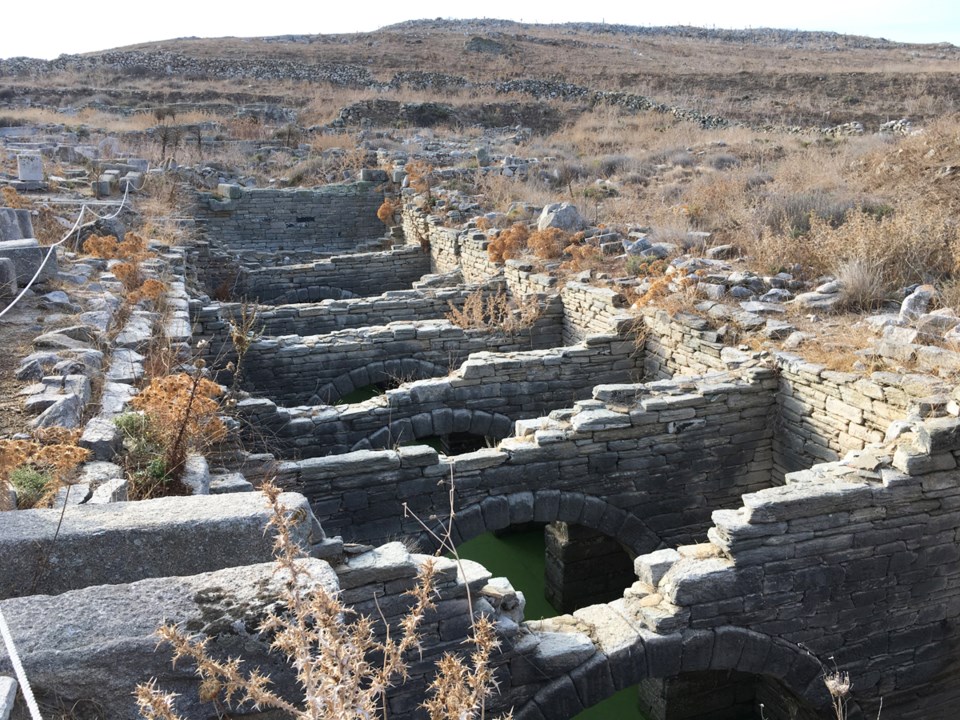The elegant Viking Star carries us through the Mediterranean and into the sun-drenched Cyclades. Stopping at Mykonos proves especially memorable.
A morning ferry transports our group of history buffs to Delos, a small island 40 minutes offshore. There, a surprising story of grandeur unfolds amid ruins and marble slabs.
“Visualize this prosperous trading centre flourishing during the third century BC,” local guide Esther suggests. “Then, a cosmopolitan population lived in elegant villas around the Sacred Harbour. Only traces of their bustling marketplace and splendid public buildings remain.”
The stone-paved Sacred Way takes us past the ancient agora, gymnasium and into the exclusive theatre district. “Over 40,000 privileged young couples and singles lived luxurious lifestyles here,” she recounts. “To keep Delos pure, a decree forbade births or deaths on this sacred island.”
Esther leads us into houses enclosing marble-columned courtyards still decorated with original mosaics, murals and remnants of fine sculpture. Many were named for their distinctive mosaics. House of Dionysus features a renowned depiction of the wine god himself…winged and riding a tiger wearing a necklace of grapes, House of Trident, a whimsical female conch, three-pronged spears and cupid flying. In House of Dolphins, eight sleek porpoises encircle an ocean motif; House of Masks depicts several different mischievous faces of Dionysus. “Ha! Likely an actors’ drinking hole,” quips Esther. And two graceful, headless replicas of its wealthy owners still front the once sumptuous House of Cleopatra.
Some structures suggest a two-storey design. One partial stairway helps us imagine covered passageways to upstairs rooms. Delos, we learn, was as parched then as today. Households collected rainwater in cisterns under their courtyard floors.
The hillside amphitheatre seating 5,500 patrons impresses us, yet adjacent ruins of a vast reservoir prove unique. “Built about 300 BC, it supplied much of the town’s water,” Esther points out.
“Tax-free, this international port attracted merchants and mariners from far away. While recognizing Apollo as chief deity, they were also welcome to build grand temples for their own gods,” says Esther. “Looking toward the foot of Mount Kythnos, you’ll see their sanctuaries. The Egyptian temple was dedicated to Isis, another to Assyria’s Baal.”
Doric columns identify Temple of Apollo. “Greeks dedicated this temple to Apollo in the seventh century BC near his mythical birthplace,” She explains. “The Delian League of Greek states also established their headquarters here, storing their treasures in massive vaults…until Pericles removed this common wealth in 454 BC to fund Athens’ monumental Acropolis.”
In the distance, weathered leonine replicas still crouch along Avenue of Lions. We learn that at one time 16 fierce marble lions guarded Sacred Lake where legendary Leto birthed Apollo, god of light, and his twin sister Artemis, goddess of the moon.
Esther tells us that most of the island’s finest artwork was pillaged. The inhabitants from neighbouring islands even ground marble statuary into lime to whitewash their homes. Valuable sculptures and other artworks were transferred to national and foreign museums. Only caretakers now live here, overseeing the site.
In the onsite museum, we view treasures unearthed during the archeological excavations. Walls exhibit mythically themed mosaics and festive murals. Glass cases present collections of intricate jewelry and figurines. Small galleries exhibit remarkable sculptures including the five original lions and Artemis with a deer.
Feral cats lazily watch us return to the wharf. “Over time, trade routes shifted, leading to the decline and abandonment of Delos. By the third century AD, only a small Christian settlement prevailed,” concludes Esther. “These restored ruins and the museum honour Delos Sanctuary’s past splendour.”
Day tripping to this World Heritage site, we glimpse ancient life on an extraordinary island.



